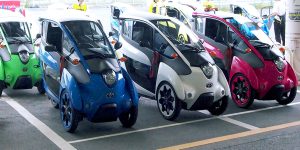Recent trends involving heavy commercial FCVs
There has been a lack of excitement surrounding fuel cell (hereinafter “FC”) vehicles, with no news of note in 2019 other than the announcement of MIRAI Concept at the Tokyo Motor Show and the announcement of Mitsubishi Fuso’s Vision F-cell concept truck. (In July, Honda made the regrettable announcement that the launch of the Clarity Fuel Cell successor model would be postponed for two or three years from the originally planned 2020 release.) In 2020, however, Japanese OEMs and their partner companies have been making announcement after announcement concerning FC trucks.
|
January 15 |
Honda Motor and Isuzu Motors concluded joint research agreement for heavy trucks with FC power trains |
Source 1 |
|
March 23 |
Toyota Motor Corporation and Hino Motors will jointly develop FC heavy trucks, and undertake practical application through driving demonstrations, etc. |
2 |
|
March 26 |
Mitsubishi Fuso Truck and Bus Corporation announced the start of mass production of FC trucks by the latter half of the 2020s, and the release of the eCanter F-Cell concept compact truck |
3 |
|
April 1 |
The FC compact truck demonstration experiment, conducted jointly by Seven-Eleven Japan and Toyota Motor Corporation, was expanded into Tochigi Prefecture in April 2019 |
4 |
Overseas, too, major OEMs, related suppliers, and start-up companies have issued releases concerning fuel cell trucks.
|
January 21 |
Sweden-based Scania, a heavy vehicle manufacturer affiliated with VW, provided four FC heavy trucks to major Norwegian wholesaler ASKO and launched operation testing |
Source 5 |
|
February 6 |
French automobile parts giant Faurecia announced a large order from Hyundai Motor Company for FC automobile hydrogen storage systems; of a total 10,000 units, 1,600 will be delivered to the FC truck joint project of Hyundai Motor Company and Switzerland-based H2 Energy |
6 |
|
February 10 |
Nikola, which is developing FC heavy trucks, announced the Badger EV pickup truck which can mount FCs to extend range |
7 |
Compatibility of FCs with heavy trucks
Heavy trucks are said to be a highly suitable application in the move toward dissemination of FC vehicles.
Heavy trucks have the following characteristics:
- Often travel long distances with cargo
- Have high environmental load, due to use of internal combustion engines (fossil fuel consumption = high CO2 emissions*)
*Fuel consumption of heavy trucks is generally said to be 2km/L on ordinary roads and 5km/L on highways.
When heavy trucks are converted into battery-powered EVs to address the latter issue, it is necessary to mount voluminous (i.e., heavy and space-consuming) batteries to secure range per charge, which eats into cargo capacity (volume and weight), the lifeline of trucks. Moreover, the larger the capacity of the battery, the longer the time required for charging and the lower the transportation efficiency. For these reasons, it is thought that FC vehicles, which offer higher energy density than batteries and can refuel in the same amount of time as internal combustion vehicles, are suitable for the electrification of heavy trucks.
In terms of infrastructure, as heavy trucks are often used for transportation between terminals, it is sufficient for hydrogen stations to be placed in terminals. Accordingly, hydrogen stations, which have yet to see widespread proliferation (with 112 commercial hydrogen stations opened and 23 planned as of March 2020, compared to the national government target of 160 by FY2020; Source 8), are unlikely to become a bottleneck to the widespread use of FCs in heavy trucks.
How much will electrification increase the vehicle weight of heavy commercial vehicles?
As battery-powered EV heavy trucks are not yet on the market, a look at the specifications of the K9 battery-powered EV heavy bus from China-based BYD that has been introduced in Japan (Source 9) shows that the bus is equipped with 324kWh batteries to secure a cruising range of 250km per charge (still only about half the range of a diesel vehicle). The vehicle weight is 14.4t, or 4.4t (approximately 44%) heavier than a diesel bus of the same class (which has a vehicle length 1m shorter but a legal boarding capacity of 31 more passengers). The weight energy density of the iron phosphate lithium batteries in the K9 is said to be approximately 90Wh/kg, meaning that the weight of the 324kWh batteries is estimated to be approximately 3.6t for the cells alone.
By contrast, Toyota’s FC bus SORA, the only large commercial FCV currently on the market, weighs approximately 2t more than a diesel bus of the same class.
|
|
Hino Blue Ribbon |
Toyota SORA |
Hino Blue Ribbon |
BYD K9 |
|
Model |
2PG-KV290N3 |
ZBC-MUM1NAE |
2PG-KV290Q3 |
ー |
|
Vehicle length (mm) |
10,430 |
10,525 |
11,130 |
12,000 |
|
Vehicle width (mm) |
2,485 |
2,490 |
2,485 |
2,500 |
|
Vehicle height (mm) |
3,045 |
3,350 |
3,045 |
3,200 |
|
Wheelbase (mm) |
5,300 |
5,300 |
6,000 |
6,200 |
|
Occupancy (including driver and standing passengers) |
79 |
79 |
87 |
56 (Japan specifications) |
|
Vehicle weight (kg) |
9,700 |
11,610 |
10,000 |
14,402 |
|
Gross vehicle weight (kg) |
14,050 |
15,955 |
14,785 |
19,700 |
|
Source |
10 |
11 |
10 |
9 |
Expectations for heavy FCVs
The FC heavy truck for which Toyota Motor and Hino Motors announced joint development in March is reported to be based on Hino Motors’ Profia heavy truck, incorporating two of the new-model MIRAI fuel cell stacks that will be released this year, and featuring a target gross vehicle weight (GVW) of 25t and a cruising range of 600km.
Honda Motor and Isuzu Motors have also announced plans to jointly research heavy trucks.
Transport efficiency—i.e., the number of tons that can be carried per truck run—is of vital importance to the transportation industry.
Gross vehicle weight = vehicle weight + cargo weight (+ occupants + fuel)
This means that the lighter the vehicle weight, the more the truck earns. (This holds true for diesel trucks as well, and weight reductions of several hundred kilograms have been achieved in the last few years through means including downsizing of engines.)
We will estimate the cargo volume that can be achieved for the FC heavy truck under joint development by Toyota Motor and Hino Motors, based on released information. This will be no more than an estimate, and we sincerely invite all concerned parties to point out erroneous assumptions and to share information to the extent possible.
To (very roughly) estimate the vehicle weight of the FC truck from the weight of diesel trucks, we will examine (with some guesses) the individual weights of the following components and make calculations.
|
Vehicle/Component |
Weight (kg) |
Notes |
Source |
|
|
Diesel truck vehicle weight |
8,680 |
Hino Profia FR1AWHG-FDBBA (flatbed truck) |
10 |
|
|
ー |
Engine |
953 |
A09C-VK |
12 |
|
ー |
Transmission |
300 |
Estimated from an Eaton transmission with similar specifications, as per-unit weight data was not available |
13 |
|
ー |
Fuel tank |
50 |
300L stainless steel tank (dry weight) |
14 |
|
+ |
Fuel cell stack/ |
300 |
Weight of MIRAI’s ASSY stack: 148kg |
15 |
|
+ |
Motive power batteries |
100 |
Assumes MIRAI motive power batteries x2 |
15 |
|
+ |
Motors |
200 |
The SORA FC bus is equipped with two of the 6JM-model motors (113kW/335Nm) mounted in the Lexus RX hybrid vehicle. As per-unit weight data for the motors is not available, weight equivalent to 4 units of the motors mounted in the Nissan Leaf (54kg/unit; total 329kW/1000Nm), for which information is available*, is assumed. |
16 |
|
+ |
Hydrogen tanks |
1,800 |
The weights of the current MIRAI’s tanks are 45kg (60L) for the front tank and 47kg (62.4L) for the rear tank. The SORA, which has a cruising range of 200km and a gross vehicle weight of 16t, is equipped with 10 MIRAI front hydrogen tanks. |
|
|
FC truck vehicle weight |
9,777 |
= Diesel truck + approximately 1,100kg |
|
In addition to the above, the standard equipment of a diesel truck includes a fuel tank carrying approximately 250kg of fuel (diesel fuel with specific gravity 0.82kg/L x 300L) when full. By contrast, the hydrogen in the 10 MIRAI hydrogen tanks mounted on the SORA FC bus is 20-23kg (at 700atm filling pressure); 40 filled MIRAI hydrogen tanks would weigh approximately 80 to 100kg, freeing approximately 150kg of load capacity.
Moreover, a diesel truck has a layout in which the engine is placed directly under the cabin and drives the rear wheels, meaning that the drive shaft becomes longer and heavier in a heavy truck. By contrast, we estimate that it will be possible to shorten the drive shaft in the FC truck by placing motors near the differential gear, or to drive the left and right rear wheels with independent motors and integrally control the motors to eliminate the differential gear, thereby reducing weight.
On the other hand, as the vehicle will carry hydrogen fuel in operation, it will be essential to protect the area surrounding the hydrogen tanks for safety, creating the need to anticipate the accompanying increase in weight.
Taking all of the above into consideration, we expect that the FC heavy truck can be realized with a weight 1 to 1.5t greater than a diesel heavy truck (with an equivalent reduction in cargo load, as gross vehicle weight is regulated for the protection of roads).
As cargo load is 12t to 13t for a diesel heavy truck of 25t gross vehicle weight equipped with a wing body (van), if the reduction in cargo load due to conversion to FCs is about 10% and if the Total Cost of Ownership is on part with diesel vehicles, some carriers may accept FCs.
Policies that mitigate regulations on gross vehicle weight for trucks that do not emit CO2 in operation may also be effective in the proliferation of the vehicles.
Seen from the perspective of CO2 emissions over the life cycle “from well to wheel,” hydrogen faces many problems that must be resolved, including energy consumption in manufacturing and in compression and storage at hydrogen stations.
However, we cannot reduce CO2 emissions by waiting for the improvement of energy density in EV batteries through next-generation batteries before in order to electrify heavy commercial vehicles.
We look ahead with anticipation toward the realization of FC heavy commercial vehicles. From the perspective of what can be achieved in the near future using existing technologies, we hold out hopes for the realization of heavy commercial FC vehicles.
Sources :
- https://www.honda.co.jp/news/2020/c200115.html
- https://global.toyota/jp/newsroom/corporate/32024051.html
- https://www.mitsubishi-fuso.com/ja/news/2020/03/26/2020%E5%B9%B4%E4%BB%A3%E5%BE%8C%E5%8D%8A%E3%81%BE%E3%81%A7%E3%81%AB%E7%87%83%E6%96%99%E9%9B%BB%E6%B1%A0%E3%83%88%E3%83%A9%E3%83%83%E3%82%AF%E3%81%AE%E9%87%8F%E7%94%A3%E3%82%92%E9%96%8B%E5%A7%8B/
- https://www.sej.co.jp/company/news_release/news/2020/2020040116.html
- https://www.scania.com/group/en/norwegian-wholesaler-asko-puts-hydrogen-powered-fuel-cell-electric-scania-trucks-on-the-road/
- https://www.faurecia.com/en/newsroom/faurecia-wins-major-award-hydrogen-storage-systems-hyundai-trucks
- https://nikolamotor.com/badger
- http://fccj.jp/hystation/index.html#hystop
- https://en.byd.com/wp-content/uploads/2019/07/4504-byd-transit-cut-sheets_k9-40_lr.pdf
https://blog.evsmart.net/ev-news/fujikyu-bus-to-procure-byd-k9-electric-bus/
- Downloaded from https://www.hino.co.jp/products/ (requires provision of personal information)
- https://global.toyota/jp/newsroom/corporate/21862392.html
- https://jafmate.jp/blog/news/170612_3.html
- https://www.eaton.com/us/en-us/catalog/transmissions/8ll-manual-transmission.specifications.html
- http://www.yokosya.jp/pdftxt/ys0002.pdf
- Manual for Proper Disposal/Recovery/Recycling of FCVs (Fuel Cell Vehicles) https://global.toyota/pages/global_toyota/sustainability/esg/challenge2050/Challenge5/proper-disposal/fcv_manual.pdf
https://www.jsae.or.jp/formula/jp/SFJ/docu/nissan_Modelnumber01.pdf












